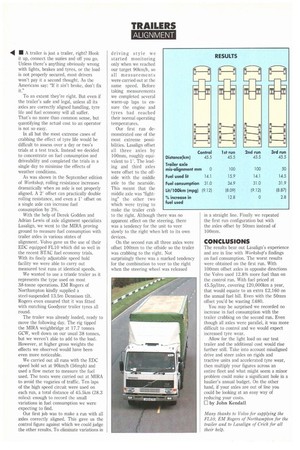IN A trailer is just a trailer, right? Hook it
Page 32

If you've noticed an error in this article please click here to report it so we can fix it.
up, connect the suzies and off you go. Unless there's anything obviously wrong with lights, brakes and tyres, or the load is not properly secured, most drivers won't pay it a second thought. As the Americans say: "If it ain't broke, don't fix it."
To an extent they're right. But even if the trailer's safe and legal, unless all its axles are correctly aligned handling, tyre life and fuel economy will all suffer. That's no more than common sense, but quantifying the actual cost to anoperator is not so easy.
In all but the most extreme cases of crabbing the effect of tyre life would be difficult to assess over a day or two's trials at a test track. Instead we decided to concentrate on fuel consumption and driveability and completed the trials in a single day to minimise the effects of weather conditions.
As was shown in the September edition of Workshop, rolling resistance increases dramatically when an axle is not properly aligned. A 20 offset can practically double rolling resistance, and even a 1° offset on a single axle can increase fuel consumption by 3%.
With the help of Derek Godden and Adrian Lewis of axle alignment specialists Lasalign, we went to the MIRA proving ground to measure fuel consumption with trailer axles in various states of alignment, Volvo gave us the use of their EDC equipped FL10 which did so well in the recent BTAC fuel economy trials. With its finely adjustable speed hold facility we were able to carry out measured test runs at identical speeds.
We wanted to use a triaxle trailer as it represents the type used on most 38-tonne operations. EM Rogers of Northampton kindly supplied a steel-suspended 13.5m Dennison tilt. Rogers even ensured that it was fitted with matching Goodyear trailer tyres all round.
The trailer was already loaded, ready to move the following day. The rig tipped the MIRA weighbridge at 17.7 tonnes GCW, well down on our usual 38 tonnes, but we weren't able to add to the load. However, at higher gross weights the effects we observed would have been even more noticeable.
We carried out all runs with the EDC speed hold set at 90km/h (56mph) and used a flow meter to measure the fuel used. The tests were carried out at MIRA to avoid the vagaries of traffic. Ten laps of the high speed circuit were used on each run, a total distance of 45.5km (28.3 miles); enough to record the small variations in fuel consumption we were expecting to find.
Our first job was to make a run with all axles correctly aligned. This gave us the control figure against which we could judge the other results. To eliminate variations in driving style we started monitoring only when we reached our target 90km/h, so all measurements were carried out at the same speed. Before taking measurements we completed several warm-up laps to ensure the engine and tyres had reached their normal operating temperatures.
Distance(km) Trailer axle mis-alignment mm Fuel used lit
Fuel consumption 31.0 Lit/100km (mpg) (9.12) % increase in
fuel used
Our first run demonstrated one of the most extreme possibilities. Lasalign offset all three axles by 100mm, roughly equivalent to 10. The leading and third axles were offset to the offside with the middle axle to the nearside. This meant that the middle axle was "fighting" the other two which were trying to make the trailer crab to the right. Although there was no apparent effect on the steering, there
was a tendency for the unit to veer slowly to the right when left to its own devices.
On the second run all three axles were offset 100mm to the offside so the trailer was crabbing to the right. Not surprisingly there was a marked tendency for the combination to veer to the right when the steering wheel was released in a straight line. Finally we repeated the first run configuration but with the axles offset by 50mm instead of 100mm.
CONCLUSIONS
The results bear out Lasalign's experience and are in line with Workshop's findings on fuel consumption. The worst results were obtained on the first run. With 100mm offset axles in opposite directions the Volvo used 12.8% more fuel than on the control run. With fuel priced at 45.5p/litre, covering 120,000km a year, that would equate to an extra £2,160 on the annual fuel bill. Even with the 50mm offset you'd be wasting £480.
You may be surprised we recorded no increase in fuel consumption with the trailer crabbing on the second run. Even though all axles were parallel, it was more difficult to control and we would expect increased tyre wear.
Allow for the light load on our test trailer and the additional cost would rise further still. Take into account misaligned drive and steer axles on rigids and tractive units and accelerated tyre wear, then multiply your figures across an entire fleet and what might seem a minor problem could make a significant hole in a haulier's annual budget. On the other hand, if your axles are out of line you could be looking at an easy way of reducing your costs.
0 by John Kendall
Many thanks to Volvo for supplying the FL10, EM Rogers of Northampton for the trailer and to Lasalign of Crick for all their help.
























































































